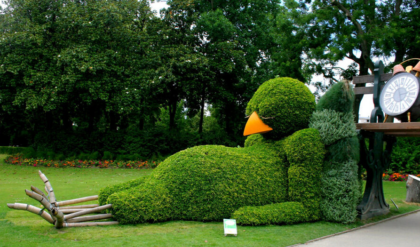Nature has always found ways to surprise us with its wonders, from breathtaking landscapes to peculiar plants. Among these natural marvels are certain fruits that astonishingly resemble human forms, sparking both amusement and intrigue. These fruits are not just a visual spectacle but also a testament to nature’s whimsical creativity. In this article, we’ll explore some of the most intriguing examples of human-shaped fruits, delving into their origins, cultural significance, and the scientific phenomena behind their unique shapes.

The Enigmatic “Nareepol” Tree
One of the most famous examples of fruits resembling humans comes from Thailand: the Nareepol tree. The word “Nareepol” translates to “woman tree” in Thai, and it aptly describes the tree’s unique fruit that strikingly resembles a woman in a reclining pose. The Nareepol tree has become a local legend and a tourist attraction, with people traveling from afar to witness its uncanny fruit.

The Nareepol tree is often surrounded by myths and stories, with some locals believing it has spiritual significance. Some say the tree brings good luck, while others view it as a sacred symbol. However, scientific explanations attribute the human-like appearance of the Nareepol fruits to natural genetic mutations and environmental factors that affect the growth patterns of the fruit. This fascinating blend of myth and science makes the Nareepol tree a topic of endless intrigue.

The Peculiar Buddha-Shaped Pears
In China, another example of human-shaped fruit can be found in the form of Buddha-shaped pears. These pears are grown using a special technique that involves placing young fruit inside Buddha-shaped molds as they grow. As the pears mature, they take on the shape of the mold, resulting in a pear that resembles a miniature Buddha.

These Buddha-shaped pears have become a popular novelty item and are often given as gifts or used as decorations during festivals. The technique of molding fruits is not only limited to pears; farmers have also experimented with other fruits, such as apples and watermelons, creating unique shapes like hearts and stars. This creative form of agriculture highlights how human ingenuity can influence nature to produce captivating results.
The “Naked Woman” Eggplant
One of the most bizarre and thought-provoking examples is an eggplant that looks eerily similar to a reclining, naked woman. This peculiar fruit, often found in Southeast Asia, has sparked a wide range of reactions, from amusement to discomfort. The resemblance is so uncanny that it raises questions about the possible reasons behind such an unusual form.

While some believe these eggplants are mere coincidences of nature, others think they might be the result of selective breeding or genetic mutations. Regardless of the cause, these “naked woman” eggplants have gained significant attention on social media, becoming viral sensations that evoke both laughter and curiosity.
The Dancing Carrots
Carrots, typically known for their elongated shape, can occasionally surprise us with their twisted, human-like forms. Some carrots grow in shapes that resemble dancing figures or intertwined limbs, adding a touch of humor to the dinner table. These “dancing carrots” are usually the result of irregular growth patterns caused by various factors, including overcrowded soil, inconsistent watering, or pest interference.

While they might not be as famous as the Nareepol tree or Buddha-shaped pears, dancing carrots have a certain charm that makes them popular among gardeners and vegetable enthusiasts. Their playful shapes remind us of the unpredictable beauty of nature and the joy it brings to our everyday lives.
The “Face” on a Potato
In 2015, a British man made headlines when he found a potato that looked remarkably like his late grandfather’s face. This “face potato,” as it was dubbed, featured distinct facial features, including eyes, a nose, and a mouth. The unusual appearance of the potato was caused by natural deformities and the random growth patterns that can occur in tubers.

Such discoveries are more common than one might think, as potatoes, being underground crops, are prone to a wide range of growth anomalies. However, finding one that closely resembles a human face is a rare and delightful occurrence that brings smiles and stories to those who encounter them.
The Mystical “Mandrake” Root
In European folklore, the mandrake root is a plant that supposedly resembles a human form and is believed to have mystical properties. It has been said that when the root is pulled from the ground, it lets out a scream that can drive a person insane. While the mythical mandrake may not be a fruit, its reputation for resembling a small human form has made it a subject of fascination for centuries.

The mandrake’s association with magic and witchcraft in medieval Europe adds a layer of mystery and allure to its already peculiar appearance. Even today, the mandrake root remains a popular symbol in literature, art, and popular culture, often used to evoke a sense of the unknown and the supernatural.
The Impact of Pareidolia
The phenomenon that causes us to see human forms in fruits, vegetables, and other inanimate objects is known as pareidolia. Pareidolia is a psychological tendency where the brain recognizes familiar patterns, such as faces or figures, in random stimuli. This explains why we often find faces in clouds, rock formations, or, in this case, fruits and vegetables.

Pareidolia is a fascinating aspect of human perception that demonstrates our brain’s incredible ability to find meaning and familiarity in the world around us. It also highlights how nature’s randomness can sometimes align in ways that create remarkably human-like forms, adding a touch of whimsy to our everyday experiences.
Conclusion
The world of fruits and vegetables is full of surprises, and those that resemble human forms are among the most intriguing. Whether it’s the legendary Nareepol tree, the skillfully molded Buddha-shaped pears, or the peculiar “naked woman” eggplants, these unique natural phenomena capture our imaginations and remind us of nature’s boundless creativity.
While some of these human-like fruits are the result of careful cultivation and human intervention, others are pure coincidences that reflect the randomness and beauty of the natural world. Regardless of their origins, these fruits serve as delightful reminders of the unexpected wonders that await us in nature’s bounty.
So, the next time you come across a fruit or vegetable that seems to have a personality of its own, take a moment to appreciate the marvels of nature and the delightful surprises it has in store for us.




